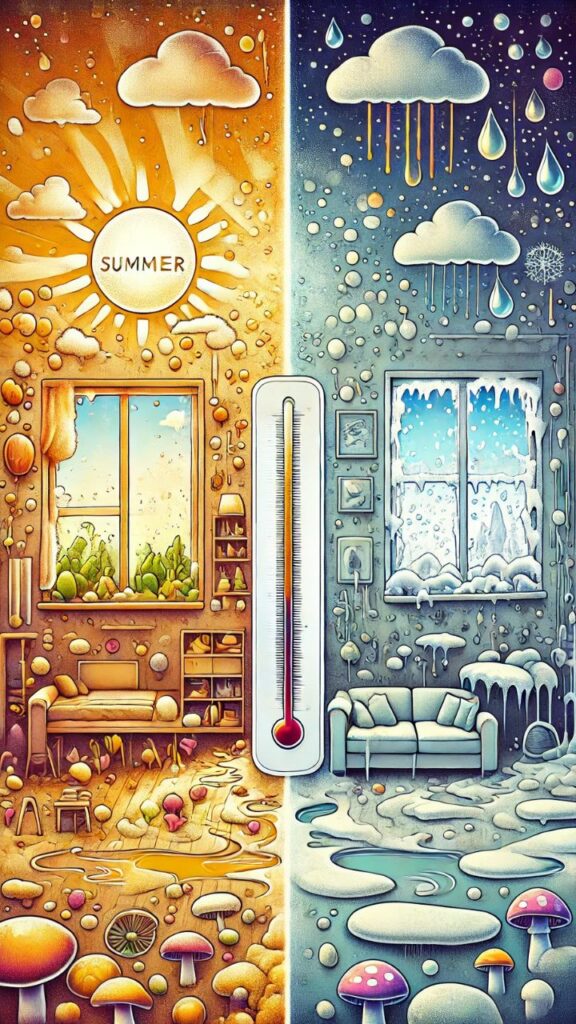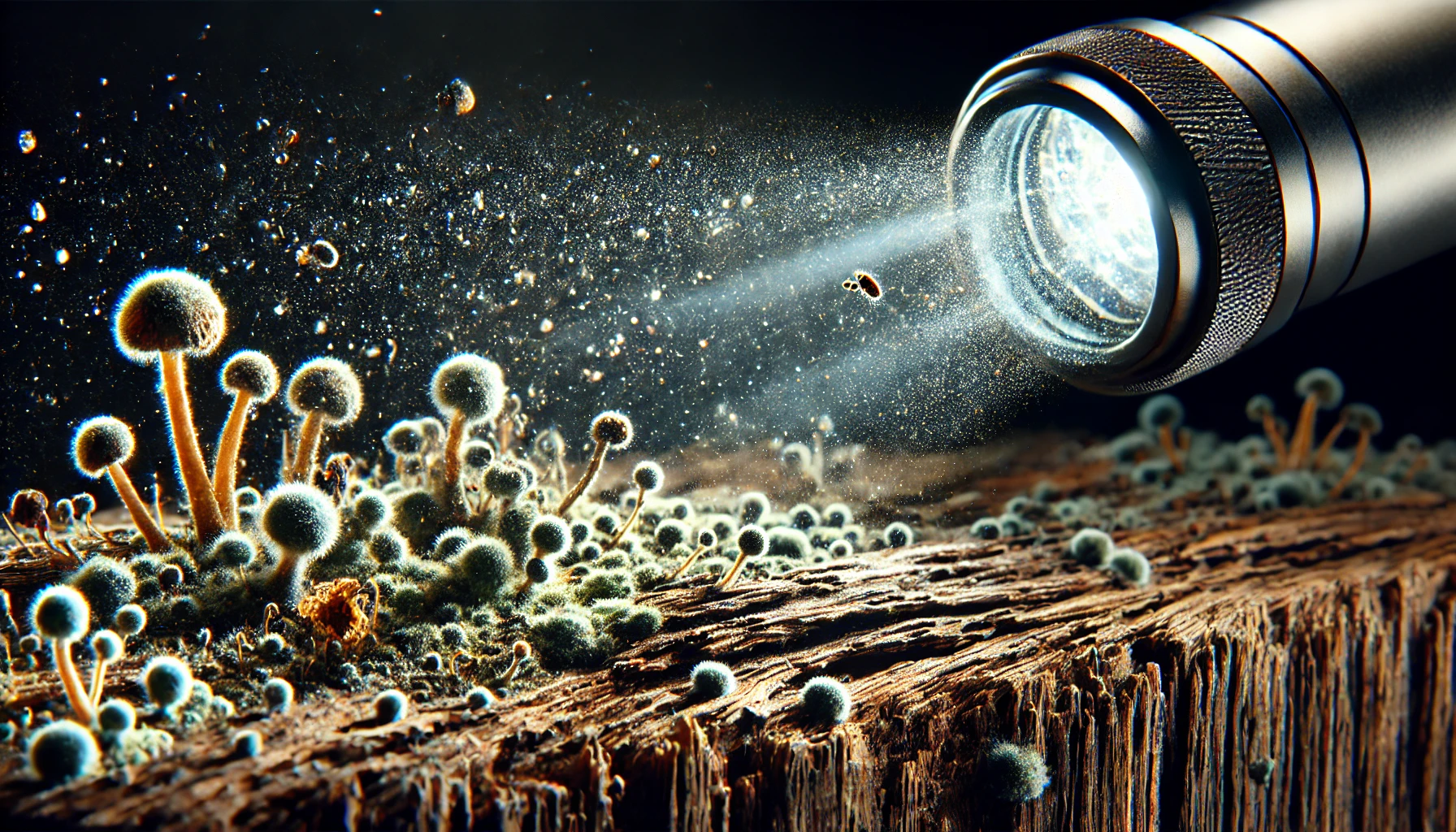Does Heat (High Temperature) Kill Mold?
TL;DR: Heat can kill mold, with effective temperatures ranging from 140-160°F (60-70°C). Exposure for 30 minutes at 400°F (200°C) can destroy most mold spores. Some sources suggest 170°C (340°F) for 1 hour to eliminate virtually all spores. Common cooking methods like boiling, baking, and frying can eliminate visible mold on food surfaces. However, heat doesn’t remove mycotoxins, which are toxins produced by some molds that can survive high temperatures. For structural mold, temperatures around 180°F have been used in remediation processes, but this method is debated as it may only make mold dormant. Mold doesn’t die at 125°F, but its growth is inhibited. While heat can be effective for surface mold, it doesn’t address underlying moisture issues or remove dead mold, which can still trigger allergic reactions. Proper mold remediation involves complete removal, not just killing spores. Alternative methods like dry ice blasting or soda blasting can be more effective for mold removal. In household settings, using heat (e.g., running an oven at its highest setting for 20-30 minutes) combined with cleaning agents like vinegar, 10-50% hydrogen peroxide, or bleach diluted 10:1 with water can help manage mold growth.
Are you dealing with mold in your home or on your food? You’re not alone. Many people wonder if heat can help get rid of mold or if it just makes things worse. Some folks are concerned about mold growing in their ovens after they haven’t been used for a while. Others worry about cooking food that has mold on it and the dangers of mycotoxins.
You might have questions like, “Does heat kill mold on walls, wood, or clothes?” or “Can boiling water really get rid of mold?” If you’re searching for answers about whether heat is a safe and effective way to fight mold, you’ve come to the right spot. In this guide, we’ll break down important information about heat and mold, helping you understand what works and what doesn’t.
If you want to know what kills mold, you can read our following guides:
What Temperature Kills Mold?
To effectively kill mold, you typically need to heat it to a temperature between 60-70°C (140-160°F). When mold spores are exposed to these high temperatures, most of them are eliminated. Common cooking methods like boiling, baking, toasting, and frying can reach these temperatures, making them effective at getting rid of mold on food.
However, it’s important to keep in mind that while heat can destroy mold, some mycotoxins—harmful substances produced by certain molds—can survive even at these high temperatures. So, eating moldy food, even after it’s been cooked, isn’t advisable because those tough toxins might still be present.
Does Mold Prefer Heat Or Cold?
Mold grows best in warm and humid places, but moisture is the main factor that helps it develop. It can thrive in both hot and cold environments as long as there’s enough moisture. Most molds prefer temperatures above 20°C (70°F). Some people think that higher temperatures, between 77°F and 86°F, can stop mold, but the real key is moisture. Keeping indoor temperatures cooler, ideally between 65°F and 75°F, can help limit mold growth. High humidity, especially above 60%, along with warm temperatures, creates a perfect setting for mold to flourish.
In colder areas, the air holds less moisture, which can lead to condensation and mold growth. Even in winter, if the air is dry, mold problems can be less severe. However, stagnant air mixed with moisture can encourage mold growth, so good air circulation is important for prevention.
A study by the SP Technical Research Institute of Sweden looked at how changing moisture and temperature affect mold growth. They tested mold growth at fluctuating temperatures of 22°C (which is good for mold) and 5°C (which isn’t as good) compared to a steady temperature of 22°C.
Mold tends to grow faster in warmer conditions, like around 22°C (72°F). In these temperatures, the mold’s processes speed up, helping it grow and spread more quickly. The study showed that when the temperature stayed constant at 22°C, mold grew rapidly compared to when the temperature was lower.
When the temperature drops, mold growth slows down. For example, at a cooler temperature of 10°C (50°F), mold still grows, but it takes more time. Even when temperatures shifted between 22°C and 5°C (41°F), the mold grew more slowly than at a steady 22°C. This indicates that while colder temperatures can slow down mold, they don’t completely stop it, especially with enough moisture around.
In another study by Haoxiang Wu and Jonathan Woon Chung Wong, two temperatures were tested: 19°C (cool, often used in libraries to protect books) and 28°C (a warmer temperature typical in homes). The results showed that mold spores survived equally well at both temperatures, indicating that mold doesn’t strongly prefer heat or cold. However, moisture, or relative humidity, is much more crucial for mold growth.
When humidity was low at 40%, the mold spores struggled to survive and showed signs of stress. On the other hand, when humidity was higher at 60% and 80%, the spores remained healthy and could grow again after drying out. The study also examined oxidative stress, which is damage that mold cells experience under stress. It found that low humidity caused more oxidative stress in the mold.
Moreover, while heat can kill mold at temperatures between 60°C and 70°C (140°F to 160°F), it doesn’t remove mycotoxins, which are harmful substances produced by some molds. So, even if the mold is killed, the toxins may still be present and can pose health risks.
Is Mold Worse In Summer Or Winter?

Mold growth is a concern all year long, but it tends to change with the seasons. Summer is usually the time when mold grows the most. This is because warmer temperatures, generally between 77°F and 86°F (25°C to 30°C), create the perfect conditions for mold spores to start growing. Research shows that as temperatures rise, mold can grow much faster, with colonies getting bigger in less time. This growth rate becomes especially noticeable when temperatures go above 68°F (20°C).
Humidity is another key factor in mold development. Summer often brings high humidity levels, exceeding 70%, which is crucial for mold to thrive. The mix of warm temperatures and high humidity creates a perfect environment for mold to spread on surfaces like walls, ceilings, and furniture. Activities in summer, such as gardening, swimming, or using air conditioning, can unintentionally raise indoor moisture levels, worsening the mold issue.
Moreover, summer often sees more rainfall in many areas, which adds to the moisture in the environment. Studies have shown a strong link between rainfall and mold spore levels, with effects lasting up to six months after it rains. This shows how important it is to deal with moisture problems quickly to avoid long-term mold issues.
Longer days and more sunlight during summer don’t directly cause mold growth, but they can raise indoor temperatures. This warmth can lead to condensation on cooler surfaces inside, especially in air-conditioned spaces, creating damp spots where mold can grow.
However, mold growth doesn’t only happen in summer. Winter brings its own challenges that can also lead to mold. When it’s cold outside and warm inside, condensation can form on windows, walls, and other cool surfaces. This dampness is great for mold to grow.
Indoor activities in winter, like cooking and showering, along with less ventilation from closed windows, can trap moisture inside homes. This humidity, especially in places like bathrooms, kitchens, and basements, creates a good environment for mold. Heating systems can lower indoor humidity but can also create warm, moist air that condenses on cooler surfaces.
Winter weather, including snow and ice, can cause problems like leaky roofs or frozen pipes. These issues add more moisture to indoor spaces, giving mold the water it needs to grow in hidden spots like attics, crawl spaces, and walls. If these moisture sources aren’t addressed, they can lead to significant mold problems.
In summary, summer usually sees more mold growth due to higher temperatures, increased humidity, and more rainfall. Outdoor mold spore levels peak in late summer and early fall, which can lead to more indoor mold issues. While winter is less favorable for outdoor mold growth, it can still create serious indoor mold problems because of condensation, trapped moisture, and possible water damage from winter conditions.
How Different Types Of Mold React To Heat?
According to research carried out by E. Rico-Munoz, J. Houbraken and R. A. Samson, Heat-resistant molds, such as Byssochlamys, Neosartorya, Talaromyces, Penicillium, Hamigera, and Monascus, handle high temperatures in different ways. Let’s look at how each of these molds behaves when things get hot.
Byssochlamys Molds
Molds like Byssochlamys fulva and Byssochlamys nivea are quite tough. They produce special spores called ascospores that can survive high heat. For example, Byssochlamys fulva can last in a sugary mix, like glucose-tartaric acid, at 194°F (90°C) for over 50 minutes. In grape juice, it holds out for 150 minutes at 185°F (85°C), but it only lasts 8 minutes in hot tomato juice at the same temperature. Byssochlamys nivea is also strong; it survives for 60 minutes in grape juice at 190°F (88°C) but only 1.5 minutes in tomato juice heated to 194°F (90°C).
Neosartorya Molds
The Neosartorya family includes molds like Neosartorya fischeri and Neosartorya glabra, known for their heat-resistant spores. Neosartorya fischeri can stick around in fruit fillings heated to 196°F (91°C) for about 2 minutes. It also lasts over 4 minutes in tomato juice at 194°F (90°C). Neosartorya glabra can handle 185°F (85°C) in grape juice for 10 minutes, with about 10% of its spores still alive.
Talaromyces Molds
Talaromyces macrosporus is another mold that can take the heat. This mold survives at 196°F (91°C) for 3 to 5 minutes in fruit fillings. Its heat resistance can change based on the type of juice or buffer solution it’s in.
Monascus and Penicillium (Eupenicillium) Molds
Monascus ruber spores also show some heat resistance. They can last about 2 minutes in a slightly sour buffer at 176°F (80°C). For Penicillium lapidosum molds, their spores can survive in blueberry juice at 178°F (81°C) for around 10 minutes, but they get killed off quickly at 200°F (93.3°C).
What Affects Mold’s Heat Resistance?
Molds’ ability to resist heat depends on outside factors, like what they’re growing in, and inside factors, such as their spore type and age. For instance, Byssochlamys fulva and Neosartorya glabra spores activate in grape juice at 158°F (70°C) in just 30 minutes. However, in plain water, Byssochlamys fulva takes 2 hours to start, while only 1% of Neosartorya fischeri spores activate at the same temperature.
Does Dryer Heat Kill Mold?
Dryers, especially the ones you find in laundromats, are pretty good at killing mold spores because they get super hot during the drying cycle. To really get rid of mold, you need to run the dryer on a high heat setting. This high temperature is important because it helps kill off mildew and mold on things like bedspreads and towels. It’s also vital to make sure everything is completely dry. If there’s any moisture left, mold can start growing again, which defeats the whole drying process.
If you have items that are really dirty or have visible mildew, it’s a smart move to wash them in hot water with detergent before tossing them in the dryer. This first wash gets rid of a lot of the mold and mildew, making the drying part work even better. While the heat from dryers can kill many mold spores, some experts caution that heat alone might not get rid of all the mold toxins. Certain mycotoxins produced by molds can survive high temperatures, so using mold-fighting products when you wash is really important. Things like borax or tea tree oil can be especially helpful for getting rid of mold.
Besides using dryers, there are other ways to deal with mildew. For example, you can put items in a sealed black plastic bag and leave them in the sun for a few days. That can also help eliminate mold. If you have larger or more valuable items that need extra care, it’s usually best to call in professional cleaning services. They can make sure everything gets cleaned properly without damaging the fabric.
Keeping your washing machines and dryers in good shape is key to preventing mold issues. Using too much detergent can lead to mildew in high-efficiency washers, so it’s important to clean the washing machine’s gasket and trap regularly to stop mold from building up. Also, cleaning out dryer ducts helps keep things running smoothly and prevents bad smells. Using a dehumidifier in your laundry area can really cut down on humidity and drying time, which helps keep mold at bay.
Does Sun Heat Kill Mold?
Sunlight can help control mold, but it’s not a guaranteed way to get rid of it completely. Higher temperatures can slow down mold growth and might kill some mold spores, but just using sunlight usually isn’t enough to eliminate mold entirely. How well sunlight works against mold depends on factors like how strong the sunlight is, how long it shines, and what type of mold it is.
The sun gives off ultraviolet (UV) rays, which can help disinfect, but the ozone layer blocks a lot of the strongest UV-C rays that are most effective against germs. Most of the sunlight we get is made up of UVA and UVB rays, which aren’t as effective for killing mold. Mold spores have developed ways to resist and fix damage caused by sunlight, so they can survive even in bright conditions.
Some mold can hide in tiny cracks or pores where sunlight can’t reach, making it harder for sunlight to do its job. While being in the sun can lower the number of germs on surfaces, it might not completely get rid of them, especially in places with complicated structures that provide shelter for them. Sunlight can dry out damp areas, which might make it harder for mold to grow, but this effect is usually temporary and doesn’t fix the underlying moisture problems.
Does Infrared Heat Kill Mold?
Infrared heat does not directly kill mold but can assist in mold management by drying out environments where mold might thrive. Infrared light primarily functions by heating surfaces, which can help reduce moisture levels.
Infrared saunas, which operate at lower temperatures ranging from 110°F to 150°F, use infrared light to heat the body directly, penetrating up to 1.5 inches into the skin.
While these temperatures may not be sufficient to kill mold outright, they can contribute to the detoxification process for individuals exposed to mold. The deep tissue penetration of infrared heat is thought to enhance circulation and oxygenation, potentially aiding recovery from mold exposure and reducing inflammation.
Does Heat Kill Mold On Food?
Heat can kill mold on food, but that doesn’t mean the food is safe to eat. When you heat food to temperatures between 60-70°C (140-160°F), most molds are effectively eliminated. However, the real issue is mycotoxins, which are harmful substances produced by some molds. These toxins can stay in the food even after cooking because many of them are heat-resistant and can survive normal cooking temperatures.
While methods like boiling, toasting, baking, or frying can get rid of visible mold, the mycotoxins often remain. The main danger from moldy food comes from these toxins, not the mold itself. Some of these toxins are heat-stable, meaning they don’t break down at boiling temperatures. Others might dissolve in water, but this depends on the specific toxin.
Even cooking methods like pressure cooking can kill mold, but they won’t remove the risk of mycotoxins still being in the food. It’s crucial to understand that mold can produce toxins that can harm human cells, which is different from how bacteria and viruses cause sickness. While heating can kill bacteria and make mold inactive, it essentially creates “hot poison” by not neutralizing these toxic byproducts.
Heat Alone Isn’t Enough: Choose Our Complete Mold Remediation Process
While heat can kill visible mold, it doesn’t fully address underlying moisture issues or eliminate harmful mycotoxins that can remain. At Mold Removal Memphis, we go beyond surface treatment with a comprehensive mold remediation process that includes inspection, containment, removal, and prevention. Our experts identify the source of mold, safely remove all traces, and apply solutions to prevent it from returning. Contact us today to ensure your home is thoroughly protected from mold for the long term.

